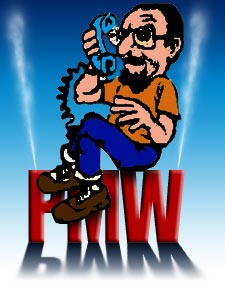|

3/7/03
|

Ed. Note:
Wady Hamam or Pro Mod Wad as he is
known in the sport as drag racing's main
nitrous Guru. He has been involved
in nitrous oxide injection almost
from its inception especially with
the Pro Mod division.. He is originally
from the Buffalo, New York area and
has been involved
in all types of racing from flat track
motorcycles to fuel dragsters. In
his wasted youth he even raced a fuel
funny car powered by a blown and injected
small block Ford! He and his brother
campaigned a front motored Top Fuel
dragster and lost a race against Don
Garlits at the now closed Niagara
Falls Dragway. His advice about nitrous
problems is highly sought after but
he is hard to get to. He has agreed
to answer one question every couple
of weeks for Drag Racing Online readers.
Email your questions to: promodwad@racingnetsource.com,
and he will answer the question he
finds most intriguing.
(Original caricature Pete Millar) |
|
Wady,
A couple of my N2O buddies were discussing the strangest nitrous tuneups they had ever encountered. One took place over a very melted-down piston. One of the guys was explaining the tuneup a pro had done on his system. The philosophy had something to do with "there are two sides to the fuel curve." This tuneup called for as low as 3.5 lbs of fuel pressure. Can you explain what he was referring to as a two-sided fuel curve?
Mike Walker
Mike,
No, I can't explain a two-sided fuel curve
because I have never heard of such a thing.
You mentioned a discussion took place over a
piston that was now an ashtray; that's what
happens with 3.5 lbs of fuel pressure, as far
as I can see.
What I do know is most, if not all, nitrous
racers and engine builders tune with pounds
per hour more than with pressure. I have heard
from some racers who, if they flow 300 lbs per
hour through a flow gauge, may see as little
as 5 lbs of fuel pressure. That amount of flowing
fuel will support a LOT of horsepower.
I know that in multi-stage systems fuel
pressures are not as high as with single and
dual stages, but a two-sided curve is not familiar
to me.
These days, with the fuel cell mounted in
the front of the car as well as the pumps, and
much shorter feed lines, lower pressures probably
do show up on the gauge or computer printouts,
but 3.5 sounds disastrous to me.
Sorry I wasn't more help.
Wady
Pro Mod Wad,
I am running a 355 c.i. Chevy 12.5 to 1 pistons, H-beam rods, factory crank, all forged pro heads with 2.08 intake valves and 50 cc combustion chambers. I have a 600-622 lift cam with 290-300 duration, and a Wiand tunnel ram with 2 660 carbs.
Would I be better off with a fogger or a dual plate system? This will also have a dedicated fuel system for the nitrous. I also plan to use a micro switch so that I'm spraying nitrous at full throttle the entire quarter-mile.
Which is more tunable?
Rich Carlson
Rich,
Definitely a direct port system. It has
way more tuneability and benefits. You can tune
each cylinder individually and really fine-tune
your system.
Plates are good, but there is a point during
your run that standoff feeding back into the
manifold from piston speed and cam overlap,
that the carb and nitrous signals will come
almost to a standstill. When this happens, the
power level flattens dramatically and the engine
will stop pulling hard.
This does not appear to happen in direct
port systems and they seem to pull hard till
shut down. By reading your plugs and adding
or subtracting nitrous and/or fuel from the
nozzle, you can get all cylinders to work the
same and make maximum power in the engine.
Wady
<
MORE STORIES >
|